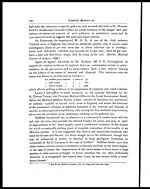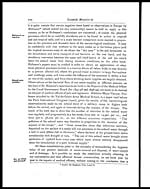Medicine - Institutions > Army health reports and medical documents > Scientific memoirs by medical officers of the Army of India > Part XII, 1901 > 6 - On some practical methods of sanitation in India with special reference to cantonments
(165) Page 121
Download files
Individual page:
Thumbnail gallery: Grid view | List view

Medical Officers of the Army of India.
121
In the second place we may cite the researches of Dr. Sidney Martin, F.R.S.,
(which are set forth in the most recent reports of the Medical Officer to the Local
Government Board), "on the growth of the Typhoid Bacillus in soil," and which,
although still in course, have resulted in the production of evidence that certain
soils, and notably cultivated garden soils, do under certain conditions provide a
favourable medium for the viability of the germ; he notes also that when the soil,
sown with the bacillus, had become so dry as to be reduced to fine powder, the
specific living contagium could be recovered therefrom. A series of experiments
made under more natural conditions by Dr. Robertson, M.O.H., Sheffield,*has
supplied evidence of equal importance as regards the persistence and viability of
the typhoid bacillus in ordinary soil.
B. Typhi in soil.
We may include in this category the forcible evidence adduced by Dr.
Waldo in the Milroy lectures of 1900 of the relations between fæcally con-
taminated dust and the prevalence of epidemic diarrhœa, which may be read in
the light of Ballard's and Tompkyns' observations into the connexion between
certain soil conditions and the same disease, and with Klein's and Hewlett's
researches into the rôle and prevalence of the B. enteriditis sporogenes as
the exciting agent of diarrhœa and cholera nostras.†
Dust and bowel
diseases.
Horton-Smith remarks, that "if we remember that the typhoid bacillus has
great power of resisting dessication, remaining alive, it may be, for over a year in
the dried condition (Schiller), it becomes easy to understand how bacilli eliminat-
ed from the body may later pass into the atmosphere in the form of dust."‡
In summing up the subject of enteric fever and soil pollution as based on the
reports made of special investigations into local outbreaks, the Medical Officer to
the Local Government Board expresses himself as follows (Report of 1898-99):—
"The failure to make a further substantial reduction in the amount of disease and
death from this cause is likely to be owing to the maintenance in the localities in question,
of conditions which involve organic pollution of the soil, and this especially where the
means of excrement disposal known as the privy-midden system is maintained."
In the third place, we have to take account of the intimate relation that
exists between the soil and the water-supply sources, and of t he soil as the source
of air-borne, insect-borne and food-borne organisms.
Pollution of water-
supplies.
As regards the ingress of micro-organisms from the upper layers of the soil
to the ground-water, much of course depends on the nature of the soil, on the
depth and range of the ground-water from the surface, and on the penetrative effects
of rainfall. The subject has not received the attention it calls for in India, and
* See "Lancet", "British Medical Journal" of September 1897.
† Medical Officer's Reports, L. G. B., for 1897-98 and 1898-99, and Trans. Jenner Institute of Preven-
tive Medicine, Vol. II, 1900.
‡ Goulstonian Lectures; "Lancet," March 24, 1900, page 826.
GG
Set display mode to: Large image | Zoom image | Transcription
Images and transcriptions on this page, including medium image downloads, may be used under the Creative Commons Attribution 4.0 International Licence unless otherwise stated. ![]()
| Permanent URL | https://digital.nls.uk/75005238 |
|---|
| Shelfmark | IP/QB.10 |
|---|---|
| Additional NLS resources: | |




